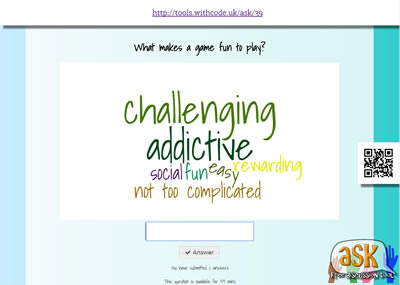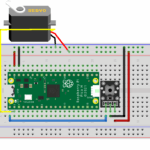This free discussion tool lets you create word clouds or bar charts that respond live to answers that your class or audience have for questions you ask them.
If your class / audience has access to the Internet, you can use it as a starter activity:
tools.withcode.uk/ask as a starter activity
Put a question on the board e.g. “What makes a game fun to play?“. Give them a few minutes to scan the QR code or type in the URL displayed on screen and watch as their responses appear in the word cloud.
You can click on any unsuitable responses to remove them (there’s no password by default but you can set one to stop people removing other people’s posts).
By default, people can add as many words as they want to the word cloud but you can change this if you only want people to add one or two (or however many) words each.
If you hover your mouse over the QR code, it gets bigger along with the link at the top of the page. This makes it easier for people to get to the page where they can answer the question you’re displaying on the board.
The more times a word is submitted, the larger the writing appears in the word cloud.
If you want to see how many times a word has been submitted, hover your mouse over it. If you want to remove that word, click on it and enter the password (blank by default).
You can also use the discussion tool to assess how much people have understood a topic at the end of a lesson / workshop:
Using tools.withcode.uk/ask to assess understanding
Use tools.withcode.uk/ask to create a question like “How much have you understood [today’s topic]?“.
Show the advanced options and type “Not at all, A little, Mostly, Completely” into the “allowed responses” box. You’ll see a preview of the option boxes that people can click on when you ask your question.
Because the responses to this tool are anonymous, you wont get a breakdown of the understanding of each student in you class / attendee at your workshop. Google forms is great if that’s what you’re looking for. But you will get an instant idea of how much your class has understood that you can then use to inform future sessions.
Remember – this tool isn’t meant to replace verbal discussions – it’s designed as a tool to stimulate and enable rich class discussions that go much deeper than they would if you had to rely on the few keenies who are willing to put up their hands.
The next page explains some of how the app works and acknowledges the code sources used.















does not work